Reading in the Nativity Scene: some symbolic aspects (II)
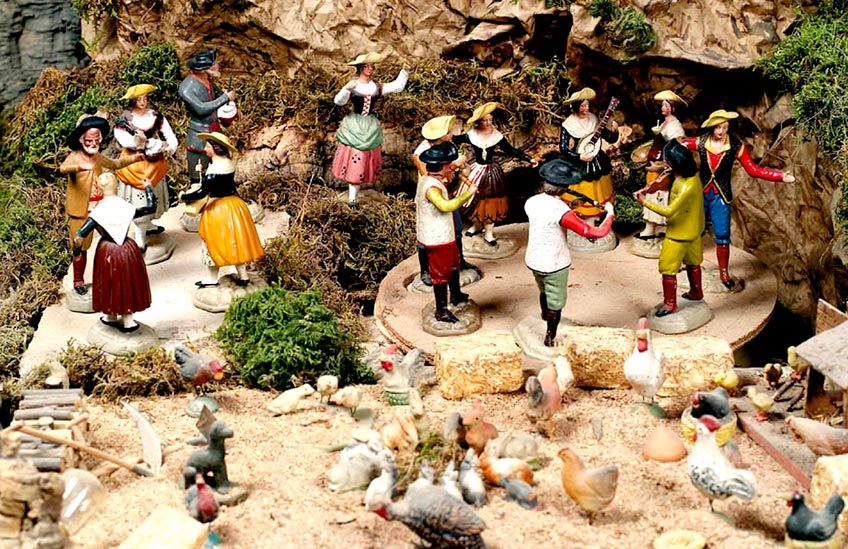
FotoCedida/Dancersand musicians in a traditional nativity scene. Murcian figures in polychrome clay from the end of the 19th century. Private collection
Angels and archangels
The winged figures of these celestial beings gave the nativity scene its most ultraterrestrial dimension. In some cases they were worshippers or offerers and in others they carried instruments of the Passion. In this respect, it should not be forgotten that everything related to the nativity scene and the Passion were linked, as they were all part of the same story.
In some cases, in the same portal the archangels Michael and Gabriel were given quotation , as in the crib of Salzillo or in that of the Recoletas of Pamplona. The reason for this is none other than the account of the birth given by Mother María Jesús de Ágreda in her Mystical City of God, where she states: "The Sacred Evangelist Saint Luke says that the Virgin Mother, having given birth to her Firstborn Son, wrapped him in cloths and laid him in a manger. And he does not state who bore him at her hands from her virginal womb, for this does not pertain to his intent. But ministers of this action were the two Sovereign Princes St. Michael and St. Gabriel, who, as they attended the mystery in corporeal human form, at the point that the human Word, penetrating with his virtue through the Virginal Thalamus, came forth, in due distance, received him into their hands, with incomparable reverence..... And when the Holy Angels presented the Child God to his Mother, the Son and Mother Most Holy looked at each other, and she wounded the heart of the sweet Child and was carried and transported by him together".
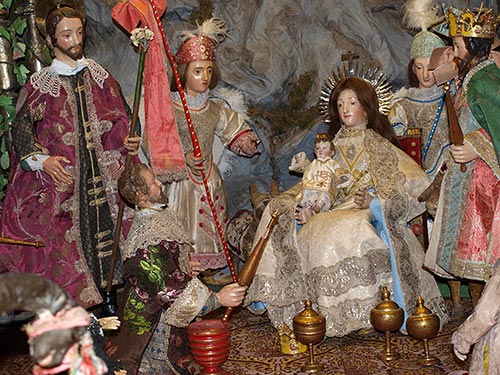
Nativity with the archangels Gabriel and Michael of the Augustinian Recollect Nuns of Pamplona, 17th and 18th centuries.
Pastors and providers
The traditional nativity scene included gleaners, market gardeners picking oranges and countless traditional trades typical of pre-industrial society. All of them formed a festive microcosm, reflecting the overflowing joy produced by the arrival of Christmas Eve. It was a veritable explosion of life, in which the Gospel texts of Saint Luke and Saint Matthew were freely reworked, with a prodigious fantasy and an artifice of invention among all the characters of everyday life, only contrasted with the splendour and wealth of the Three Wise Men.
Of particular interest are the groups of dancers and musicians who, in the streets and squares of the three-dimensional structure of the Nativity Scene, enlivened the atmosphere to an unsuspected degree, as old people, hunchbacks and crippled people danced to the sound of tambourines, zambombas, rattles and even wind and string instruments. The exaltation of gaudium, which pervaded the houses and liturgical celebrations of those days, was reflected in the popular crib, not only in the dancers and musicians, but also in the gestures of shepherds and peasants, both in the market and in ordinary work, as well as in the jubilant farmwomen on donkeys, with their corresponding gifts, who sang and played pastoral instruments. There is an abundance of passers-by, offerers, men working in their vegetable gardens, or having lunch in inns with the typical fried eggs or cooking migas in huge frying pans.
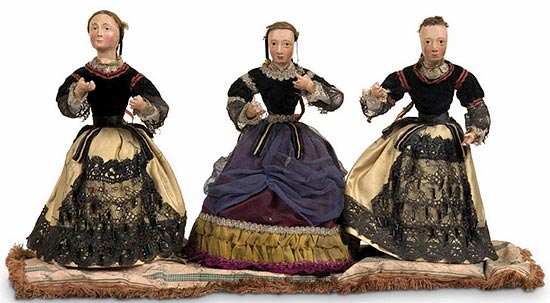
Widows from the nativity scene of the Augustinian Recollect Sisters of Pamplona, 17th century
All these figures are a faithful reflection of a rural, pre-industrial society, as are the tiny cork houses. The traditional costumes are those of the Manchegans, Maragatos or huertanos of that Spain before the railway and all the industrial take-off. The men are dressed in Spanish capes, catites, chambergos, shirts, breeches, abarcas, zamarras and gaiters, and the women in sayas, aprons, over-skirts, scarves and hats. The trades and types represented are varied: farmers, stockbreeders, hunters, fishermen, blacksmiths, wine merchants, market gardeners, shopkeepers and craftsmen of all kinds subject, with no lack of the destitute such as widows, cripples and beggars, to signify that the Messiah had come for all of them.
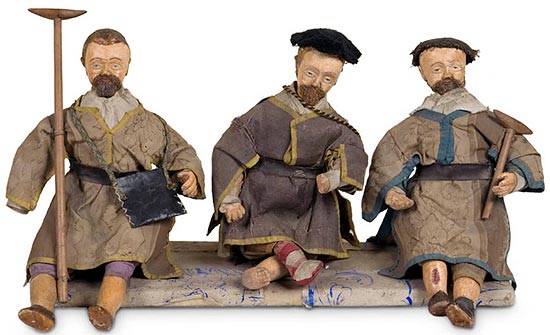
Cripples from the nativity scene of the Augustinian Recollect Nuns of Pamplona, 17th century
Vitality and spontaneity were guaranteed in that story, which was meant to be lived and not only referred to. In the case of the Hispanic nativity scenes, the nativity was not lost, as in Naples, among an extroverted and even crazy people, but the scene became the centre of the whole story.
It makes little difference whether the event takes place in winter, some wear warm clothes, others walk around in a simple waistcoat, harvest or pick the most varied fruits, while old and young dance, delouse their husbands and fathers or devote themselves to the most varied tasks of the house and the agro-pastoral environment. Many of these types can be identified with the engravings of Spanish folk costumes printed by Juan de la Cruz.
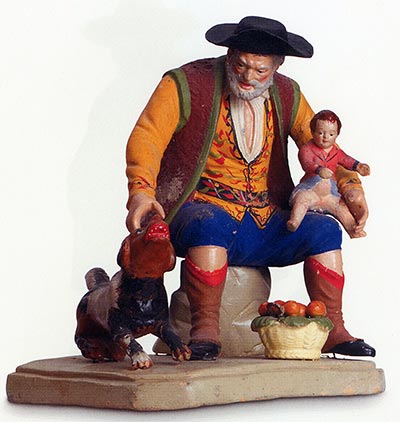
Shepherd with child and dog in polychrome clay. Murcian workshops, ca. 1885. Private collection.
The Magi, Herod and the slaughter of the innocents
The magi, usually on horseback, are dressed as western monarchs with ermine, rich cloaks, crowns and sceptres. In the past, they symbolised the three known continents, but in the nativity scene period they are often associated with the three ages of man. Their main significance is that they are revealed to us as the great manifestation, the Epiphany. Their gifts are associated with the Child King (gold), the Child God (frankincense) and the human Word (myrrh).
In the first centuries, the primitive clothing of the magi was colourful and colourful, typical of the priests and wise men of the East. Later, during the Romanesque period, it became simpler, while their headdress was replaced by the royal crown. In this respect, it should be remembered that the concept of the magician had acquired a pejorative tone, being equated with that of the sorcerer, and there was a desire to dignify their image by attributing a royal position to them. In the art of the centuries of the Modern Age, also in nativity scenes, the Magi appear on horseback, with spectacular processions, dressed as Western monarchs, with ermine and rich cloaks, accompanied by crowns and sceptres.
Herod, too, used to dress like a king. Alongside his soldiers dressed in Roman style, with their skirts, armour and helmets, those who sacrifice the innocents wear turbans-like caps with red pointed tops, which link them to the executioners in painting from the end of the Middle Ages average and which appear so often in the scene of the Beheading of the Baptist.
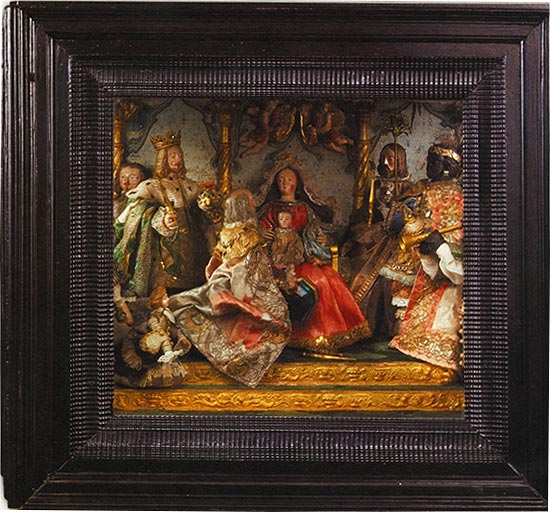
Window of the Epiphany of the Augustinian Recollect Sisters of Pamplona, a. 1731
To find out more
ARBETETA MIRA, L., "Metodología y cuestiones previas para el estudio de los Nacimientos españoles", Revista de Dialectología y Tradiciones Populares, t. 48 (1993), pp. 169-212.
ARBETETA MIRA, L., Oro, incienso y mirra. Nativity scenes in Spain. Madrid, Telefónica. Fundación Germán Sánchez Ruipérez, 2000.
FERNÁNDEZ GRACIA, R., A Belén pastores! Belenes históricos en Navarra, Pamplona, Government of Navarre-Pamplona City Council, 2007.
PEÑA MARTÍN, A., La Navidad en España en el siglo XIX. El Nacimiento y sus tradiciones, A. Peña Martín, 2016.
